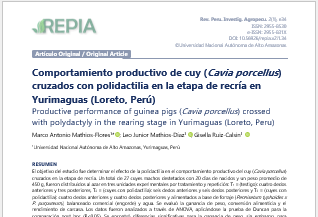Productive performance of guinea pigs (Cavia porcellus) crossed with polydactyly in the rearing stage in Yurimaguas (Loreto, Peru) The objective of the study was to determine the effect of polydactyly on the productive performance of crossbred guinea pigs (Cavia porcellus) in the rearing stage. A total of 27 weaned male guinea pigs, of 20-days old and with an average weight of 450 g, were randomly distributed in three experimental units per treatment and repetition: T1 = (control): four anterior and three posterior toes, T2 = (guinea pigs with polydactyly): six anterior toes and six posterior toes and T3 = (guinea pigs with polydactyly): four anterior toes and four posterior toes and fed with forage (Pennisetum typhoides x P. purpureum), commercial feed (fattening stage) and water. Weight gain, feed conversion, and carcass yield were evaluated. Data were analyzed through ANOVA, applying Duncan's test for post hoc comparison (P<0.05). Significant differences were found for weight gain, however, for feed conversion and carcass yield there were no significant differences between treatments.
DOI:
https://doi.org/10.56926/repia.v2i1.34Keywords:
consanguinity, guinea pigs, heritability, genetic malformationAbstract
The objective of the study was to determine the effect of polydactyly on the productive performance of crossbred guinea pigs (Cavia porcellus) in the rearing stage. A total of 27 weaned male guinea pigs, of 20-days old and with an average weight of 450 g, were randomly distributed in three experimental units per treatment and repetition: T1 = (control): four anterior and three posterior toes, T2 = (guinea pigs with polydactyly): six anterior toes and six posterior toes and T3 = (guinea pigs with polydactyly): four anterior toes and four posterior toes and fed with forage (Pennisetum typhoides x P. purpureum), commercial feed (fattening stage) and water. Weight gain, feed conversion, and carcass yield were evaluated. Data were analyzed through ANOVA, applying Duncan's test for post hoc comparison (P<0.05). Significant differences were found for weight gain, however, for feed conversion and carcass yield there were no significant differences between treatments.
Downloads
References
Arbulú López, C. A., & Del Carpio Ramos, P. A. (2015). Rendimiento y contenido graso de cuyes (Cavia porcellus) mejorados, sacrificados a la octava y duodécima semana de edad. Revista de Investigación y Cultura, 4(1), 20–32. https://www.redalyc.org/pdf/5217/521751973002.pdf
Benítez González, E., Ullaguari Ramirez, V., Guzmán Simbaña, J. P., & Abad Guamán, R. (2017). Estado de la polidactilia en poblaciones de cobayos (Cavia porcellus) en el cantón Loja , como indicador de su estatus genético. Centro de Biotecnología, 6, 36–40. https://docplayer.es/124281890-Estado-de-la-polidactilia-en-poblaciones-de-cobayos-cavia-porcellus-en-el-canton-loja-como-indicador-de-su-estatus-genetico.html
Chauca Francia, L. J., Muscari Greco, J., & Higaonna Oshiro, R. (2005). Generación de líneas mejoradas de cuyes de alta productividad [Instituto Nacional de Investigación Agraria]. https://hdl.handle.net/20.500.12955/338
Chauca, L., Vergara, V., Reynaga, M., Muscari, J., & Higaonna, R. (2008). Avances en nutrición y alimentación en cuyes. XXXVIII Reunión Científica Anual de la Asociación Peruana de Producción Animal - APPA. https://repositorio.inia.gob.pe/bitstream/20.500.12955/432/1/Chauca-Evaluacion_del_crecimiento_de_cuyes.pdf
Correa, V., & Malea, J. (1981). Efecto de la polidactilia en el crecimiento y engorde de cuyes (Cavia porcellus) [Instituto Nacional de Investigacion Agraria]. https://agris.fao.org/agris-search/search.do?recordID=PE19970079590
Falconer, D. S., & Mackay, T. F. C. (2001). Introducción a la genética cuantitativa (1st ed.). ACRIBIA.
Flores-Mancheno, C. I., Duarte, C., & Salgado-Tello, I. P. (2017). Caracterización de la carne de cuy (Cavia porcellus) para utilizarla en la elaboración de un embutido fermentado. Ciencia y Agricultura, 14(1), 39–45. https://doi.org/10.19053/01228420.v14.n1.2017.6086
Kirnew, M. D., Nagashima, J. C., Gomes, I. T., Manzano, J. E. D., & Santos, M. S. (2010). Polidactilia em suínos - Relato de Caso. Revista Científica Electrónica de Medicina Veterinaria, 7(14), 1–7. http://faef.revista.inf.br/imagens_arquivos/arquivos_destaque/7eAl9J2eAW29Sc3_2013-6-25-14-48-55.pdf
Mantilla Guerra, J. (2009). Mejoramiento Genético y Conservación de Cuyes Nativos en el Perú. Sistema de Revisiones en Investigación Veterinaria de San Marcos. https://docplayer.es/17726848-Mejoramiento-genetico-y-conservacion-de-cuyes-nativos-en-el-peru.html
Meza Bone, G. A., Cabrera Verdezoto, R. P., Morán Morán, J. J., Meza Bone, F. F., Cabrera Verdesoto, C. A., Meza Bone, C. J., Meza Bone, J. S., Cabanilla Campos, M. G., López Mejía, F. X., Pincay Jiménez, J. L., Bohórquez Barros, T., & Ortiz Dicado, J. (2014). Mejora de engorde de cuyes (Cavia porcellus L.) a base de gramíneas y forrajeras arbustivas tropicales en la zona de Quevedo, Ecuador. Idesia (Arica), 32(3), 75–80. https://doi.org/10.4067/S0718-34292014000300010
Montes Andía, T. (2012). Guia Tecnica “Asistencia Técnica Dirigida en Crianza Tecnificada de Cuyes.” Producción Agropecuaria. https://plataformaiestphuando.com/books/guia-tecnica-asistencia-tecnica-dirigida-en-crianza-tecnificada-de-cuyes/
Nájera Verdezoto, L. A., & Vaca Guerra, M. S. (2016). Parámetros reproductivos de cuyes (cavia porcellus) con polidactilia en Quiroga, Cotacachi, provincia de Imbabura [Universidad Técnica del Norte]. http://repositorio.utn.edu.ec/handle/123456789/5964
Núñez Freire, M. del P. (2011). Evaluación Productiva de Cuyes con Polidactilla [Escuela Superior Politécnica de Chimborazo]. http://dspace.espoch.edu.ec/handle/123456789/1186
Ortiz-Oblitas, P., Florián-Alcántara, A., Estela-Manrique, J., Rivera-Jacinto, M., Hobán-Vergara, C., & Murga-Moreno, C. (2021). Caracterización de la crianza de cuyes en tres provincias de la Región Cajamarca, Perú. Revista de Investigaciones Veterinarias Del Perú, 32(2), e20019. https://doi.org/10.15381/rivep.v32i2.20019
Rico Numbela, E. (2009). Planteles de cuyes locales e introducidos en Bolivia. DOCPLAYER. https://docplayer.es/67270619-Planteles-de-cuyes-locales-e-introducidos-en-bolivia.html
Rojas Bruzón, R., Jimenes Hechavarría, Y., Jhonson Montero, E., & Lores Cruz, A. (2022). Polidactilia poliaxial. Presentación de casos. MediSur, 20(3). http://scielo.sld.cu/pdf/ms/v20n3/1727-897X-ms-20-03-560.pdf
Rosales-Jaramillo, C., Róman-Bravo, R., & Aranguren-Méndez, J. (2021). Morfometría y faneroptica de subpoblaciones de cobayos (Cavia porcellus) nativos del altiplano sur ecuatoriano. Revista Científica de La Facultad de Ciencias Veterinarias, XXXI(2), 71–79. https://doi.org/10.52973/rcfcv-luz312.art4
Sánchez-Macías, D., Barba-Maggi, L., Morales-de la Nuez, A., & Palmay-Paredes, J. (2018). Guinea pig for meat production: A systematic review of factors affecting the production, carcass and meat quality. Meat Science, 143, 165–176. https://doi.org/10.1016/j.meatsci.2018.05.004

Published
How to Cite
Issue
Section
License
Copyright (c) 2023 Marco Antonio Mathios-Flores, Gisella Ruiz-Calsin, Leo Junior Mathios-Díaz

This work is licensed under a Creative Commons Attribution 4.0 International License.
Authors retain their rights:
a. The authors retain the intellectual property rights (copyright) of the published works, assigning to the journal the right of first publication.
b. Authors retain their trademark and patent rights, and also on any process or procedure described in the article.
c. Authors retain the right to share, copy, distribute, perform and publicly communicate the article published in REPIA (e.g., place it in an institutional repository or publish it in a book), with an acknowledgement of its initial publication in REPIA.
d. Authors retain the right to make a subsequent publication of their work, to use the article or any part of it (e.g., a compilation of their work, notes for conferences, theses, or for a book), provided they indicate the source of publication (authors of the work, journal, volume, number, and date).







